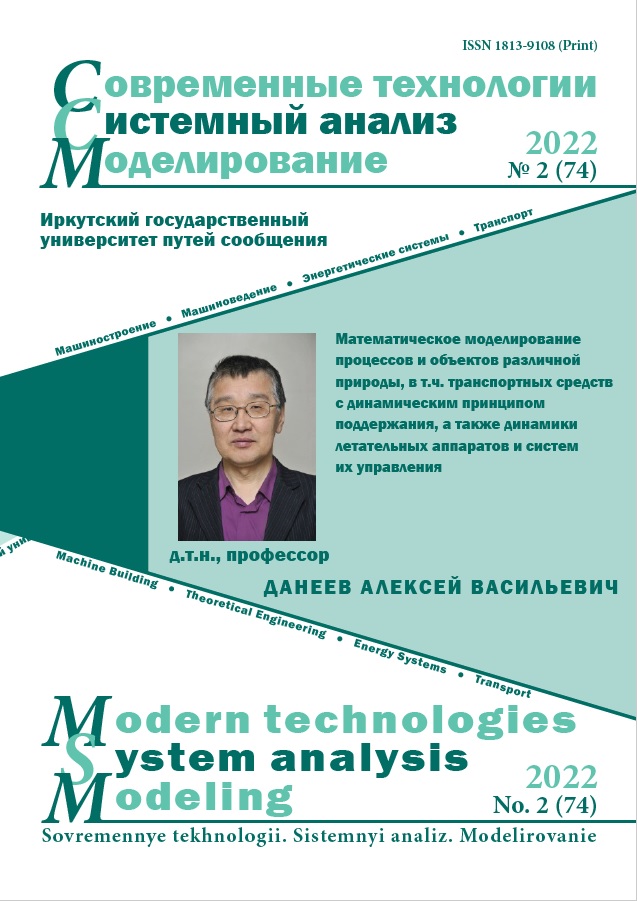System analysis of the technology of energy supply of train traction
Keywords:
Enegy supply technology, three phase twelve pulse rectifier, converter transformer, spectral analysis, harmonic components, phase voltage, current, electric traction of a trainAbstract
The analysis of the main power units operation of electric traction of trains is aimed at improving the energy supply for heavy and high-speed trains driving to increase the throughput and carrying capacity of the railway. The proposed system analysis of the electric traction efficiency is based on the application of an amended law of conservation of energy in an electromagnetic field. It is also based on new energy characteristics of power units and the use of spectral analysis of voltage and current in the outlines of an electrical circuit. A study of high-voltage DC electric traction was carried out with the use of three-phase twelve-pulse serial rectifiers at traction converter substations. This study confirmed the high level of electrical energy quality indicators at the input. The coefficient of distortion for the sinusoidal curve of the phase voltage on the primary winding of the converter transformer is 0.71%. The odd harmonic components of the phase current in the windings of the substation transformer up to the nineteenth harmonic exceed 1% of the current of the first harmonic. They are shifted in phase by angles close to 90 or 270 electric degrees relative to the eponymous phase voltage harmonics and form the corresponding reactive power. If secondary windings connected according to the "triangle" scheme are used, then phase current harmonics multiple of three exceed the other harmonic components of the current in magnitude and contribute to the additional current loading of the external power supply system. In the study of electric traction using three-phase rectifiers designed in the Irkutsk State Transport University, the possibility was shown to reduce the consumption by 4.4% of active power from the external power supply system. The coefficient of distortion in the phase voltage sinusoidal curve on the primary winding of the converter transformer is 0.6%. As a load of traction converter substations located at a distance of 50 km, the traction of three connected trains with a total mass of 22,500 tons at a speed of 50 km/h in the middle of the inter-substation zone was used. Loading the contact suspension with a current of no more than 947.5 A allows not to change the cross-section of the current-carrying wires of the contact suspension, which is mainly used in the AC contact network with a voltage of 25 kV, 50 Hz. The efficiency of electric traction of trains increases by 3.5% as compared to the traction by twelve-pulse rectifiers with a voltage of 37.1 kV.
References
Прогноз научно-технологического развития Российской Федерации на период до 2030 года. М. : М-во образования и науки РФ, 2014. 244 с.
Чернов Ю.А. Электроснабжение железных дорог. М. : УМЦ ЖДТ, 2016. 406 с.
Аржанников Б.А. Тяговое электроснабжение постоянного тока скоростного и тяжеловесного движения поездов. Екате-ринбург : Изд-во УрГУПС, 2012. 207 с.
Салита Е.Ю., Ковалева Т.В., Комякова Т.В. Обоснование внедрения двенадцатипульсовых выпрямителей последова-тельного типа в системе электроснабжения метрополитена // Изв. Транссиба. 2020. № 1 (41). С. 11–20.
Бурков А.Т. Электроника и преобразовательная техника. М. : УМЦ по образованию на ж.-д. трансп., 2015. Т. 2. 307 с.
Динамические процессы в асинхронном тяговом приводе магистральных электровозов / Ю.А. Бахвалов, Г.А. Бузало, А.А. Зарифьян и др. М. : Маршрут, 2006. 374 с.
Преобразователь выпрямительно-инверторный ВИП-1000-У1 : руководство по эксплуатации ИЕАЛ.435411.046 РЭ. Саранск : Электровыпрямитель, 2008. 35 с.
Francesco V., Luigi I. Dynamic and Control of Switched Electronic Systems // Advanced Perspectives for Modeling, Simulation and Control of Power Converters. London : Springer, 2012. 492 p.
Рябченок Н.Л., Алексеева Т.Л., Астраханцев Л.А. Новые возможности повышения эффективности образовательного процесса в учебных заведениях высшего образования // Современные проблемы профессионального образования: опыт и пути решения : материалы III всерос. науч.-практ. конф. с междунар. участ. Иркутск, 2018. С. 837–842.
Маевский О.А. Энергетические характеристики вентильных преобразователей. М. : Энергия, 1978. 320 с.
Akagi H., Watanabe E., Aredes M. Instantaneous power theory and applications to power conditioning. The power engineering: Handbook. New York : Wiley, 2007. 379 p.
Хохлов Ю.И., Сафонов В.И., Лонзингер П.В. Внешние и энергетические характеристики двенадцатифазных компенси-рованных выпрямителей с векторным управлением // Вестн. Южно-Урал. гос. ун-та. Сер. Энергетика. 2014. Вып. 4. № 14. С. 37–45.
Poynting J.H. On the Transfer of Energy in the Electromagnetic Field. Philosophical Transactions of the Royal Society of Lon-don. 1884. № 175. Р. 343–361. doi.org/10.1098/rstl.1884.0016.
Демирчан К.С., Нейман Л.Р., Коровкин Н.В. Теоретические основы электротехники. СПб. : Питер, 2009. Т. 2. 431 с.
Афанасьев Б.П., Гольдин О.Е., Кляцкин И.Г. Теория линейных электрических цепей. М. : Высш. шк., 1973. 592 с.
Уточненный закон сохранения энергии / Н.Л. Рябченок, Т.Л. Алексеева, К.П. Якобчук и др. : Rusnauka : сайт. URL: http://www.rusnauka.com/42_PRNT_2015/Tecnic/5_202603.doc.htm (Дата обращения: 01.04.2022).
Энергетическая эффективность в электрических цепях с полупроводниковыми приборами / Т.Л. Алексеева,
Н.Л. Рябченок, Л.А. Астраханцев и др. // Вестн. Южно-Урал. гос. ун-та. Сер. Энергетика. 2020. Т. 20. № 2. С. 89–98. DOI: 10.14529/power200208.
Инновационные перспективы тягового электроподвижного состава / А.В. Воротилкин, Н.Л. Михальчук, Н.Л. Рябченок и др. // Мир транспорта. 2015. Т. 13. № 6. С. 62–76.


